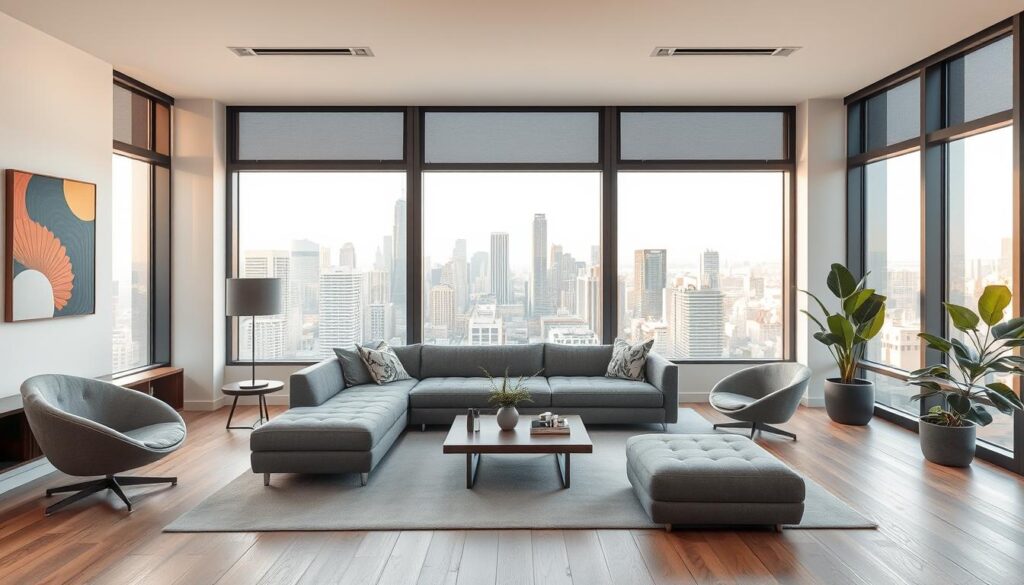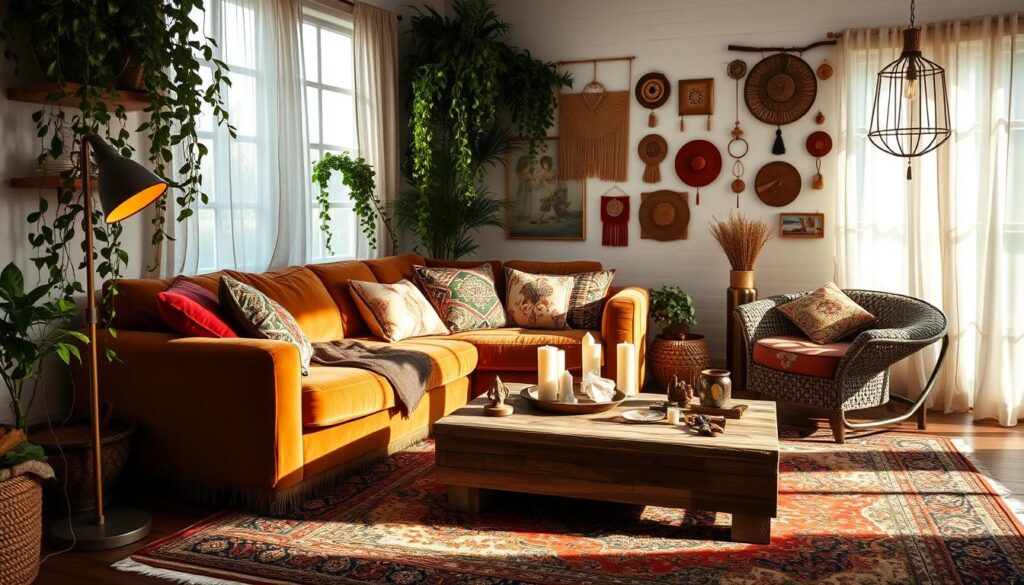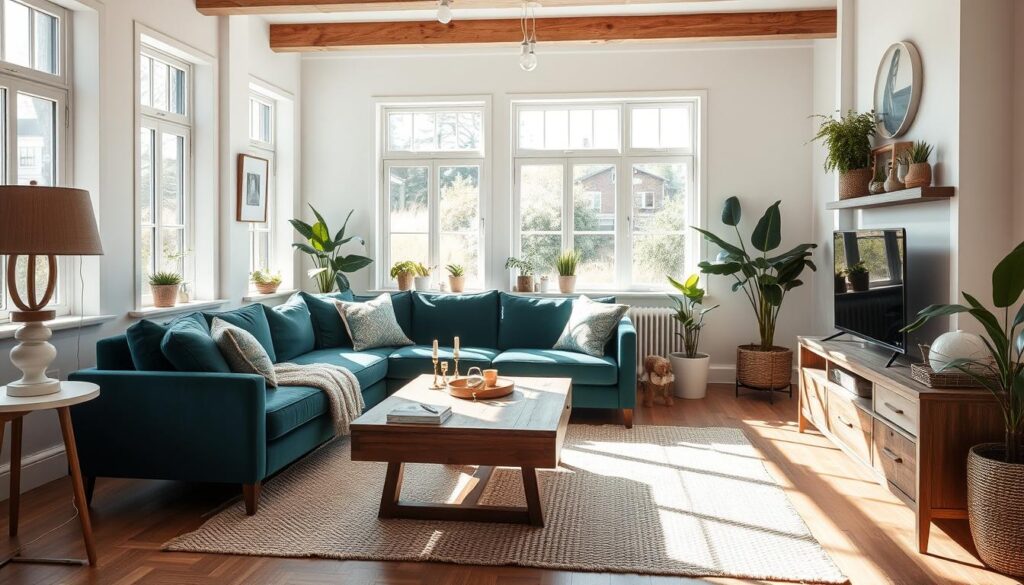Did you know that how we design our homes can really affect our mood and well-being? With more people wanting homes that show their personality, home interior design styles are becoming very important.
We’ll look at the top design styles to turn your home into a cozy and elegant space. We’ll cover everything from modern minimalism to traditional coziness. You’ll learn what makes each style special, its benefits, and how to get inspired. This will help you choose the right look for your home’s aesthetic.
Key Takeaways
- Discover the most popular design styles to transform your living space
- Learn about the characteristics and benefits of each style
- Get inspiration to make informed decisions about your home’s aesthetic
- Explore how different styles can impact your mood and productivity
- Create a haven that reflects your personality and style
Understanding the Importance of Interior Design Styles
Interior design styles are key to our mood and productivity. It’s more than making our homes look good. It’s about creating spaces that support our well-being and show who we are.
Whether it’s modern interior design or traditional interior design, styles let us express ourselves. They help us create spaces that are both useful and beautiful.
The Role of Design in Our Lives
Design is a big part of our daily lives. It affects how we feel and interact in our homes. A well-designed home can lift our mood, boost our productivity, and even improve our health.
The elements of design, like color, texture, and lighting, shape our environment. For example, bright colors and natural light can make a room feel bigger and more welcoming.
| Design Element | Effect on Ambiance | Example |
|---|---|---|
| Color | Influences mood and energy | Bright colors for a lively atmosphere |
| Texture | Adds depth and tactility | Rug in a living room for coziness |
| Lighting | Impacts visibility and warmth | Table lamps for a cozy reading nook |
How Design Styles Reflect Personal Taste
Our choice of interior design styles shows our personal taste and preferences. Whether we like the clean lines of modern design or the classic feel of traditional design, our choices tell a story about us.
For instance, someone who likes modern interior design might value simplicity and practicality. On the other hand, someone who prefers traditional interior design might enjoy classic beauty and comfort.
By knowing the different interior design styles and what they offer, we can design our homes to reflect our personalities and meet our needs.
Modern Interior Design: Clean Lines and Functionality
Modern interior design is known for its sleek look and focus on being useful. It’s not just a trend; it’s a lifestyle that values simplicity, usefulness, and being connected to nature.
Key Features of Modern Design
Modern design is all about clean lines, few decorations, and being practical. It uses materials like steel, glass, and concrete for a modern look. Open floor plans make spaces feel bigger and more connected.
Big windows and skylights are key to bring in natural light. This reduces the need for artificial lights and links us to the outdoors.
Popular Color Palettes in Modern Homes
Modern homes often stick to a monochromatic scheme or mix neutral colors with bold ones. Monochromatic schemes bring calmness, while bold colors add personality.
To add modern design to your home, start with neutral colors. Then, add color with furniture and decor. Learn more about interior design styles and how to mix them in our guide here.
Traditional Interior Design: Timeless Elegance
Traditional interior design is warm and sophisticated. It’s a classic way to decorate that makes homes feel both comfortable and elegant.
This style combines the beauty of the past with a cozy, inviting feel. It loves rich wood tones, intricate patterns, and soft furnishings.
Elements That Define Traditional Style
Several key elements make up traditional interior design. Rich wood tones add warmth and depth. Ornate patterns, like detailed carpets and wallpaper, also add to the traditional feel.
Comfortable furniture is essential, with plush sofas and armchairs being key. Classic accessories, like antique vases and ornate mirrors, add sophistication.
Iconic Furniture Pieces to Consider
Choosing the right furniture is crucial for a traditional-style home. The wingback chair is a classic choice, offering both comfort and elegance.
The four-poster bed is another timeless option, making a stunning focal point in bedrooms. Other must-haves include ornate wooden dressers, Chesterfield sofas, and beautifully crafted coffee tables.
By using these elements and furniture pieces, homeowners can create a traditional interior design. This design is warm, sophisticated, and timeless.
Contemporary Interior Design: Current Trends
The world of interior design is always changing. It shows what’s popular today. We see a big focus on being green, using new tech, and finding new materials.

Characteristics of Contemporary Style
Today’s interior design is all about simplicity. It has clean lines and doesn’t have too much decoration. It also brings nature inside.
- Open floor plans make spaces feel bigger and more open
- Using materials that are good for the planet
- Adding tech for smart homes
- Neutral colors with a splash of bold ones
This mix creates a modern, stylish home that works well and looks great.
Blending Old and New Elements
Today’s design is great at mixing old and new. It’s done by:
- Mixing old furniture with new decor
- Adding antique or reused wood to designs
- Using old skills in new ways
This way, we make a space that’s both unique and tells our story.
For example, an old armchair can get a new cover and sit next to a modern sofa. This creates a cool contrast. Adding mid-century modern touches, like classic furniture or colors, also adds character to modern spaces.
Rustic Interior Design: Embracing Nature
Rustic interior design combines the indoors with the outdoors, making spaces cozy and organic. It celebrates natural materials and the outdoors, adding warmth and character to any room.
Materials Commonly Used in Rustic Design
Rustic design often uses reclaimed wood, stone, and brick. These materials add texture and warmth, bringing history and authenticity to a room. For example, reclaimed wood can be used for flooring or as a statement piece, like a wooden beam ceiling.
To learn more, visit The Spruce’s guide on rustic design.
Stone and brick are also key for a rustic look. They can make a feature wall or part of a fireplace, enhancing a room’s cozy feel. Using these materials makes your home feel more connected to nature.
Creating a Cozy Atmosphere
Creating a cozy atmosphere is key in rustic design. Use warm lighting like table lamps or floor lamps with natural linen shades. Also, add plush textiles like wool throws and velvet pillows. This makes your home feel like a retreat.
Adding natural elements like plants, antlers, or vintage artifacts also enhances the rustic feel. The goal is to make your space feel organic and lived-in, where every element has a story.
Minimalist Interior Design: Less is More
Minimalist design is more than just getting rid of clutter. It’s a choice that makes every item in a room count. It brings calm and serenity to your home through simplicity and clean lines.
Principles of Minimalism in Home Decor
At its core, minimalist design is about simplicity, functionality, and a few colors. Simplicity means cutting out the extra stuff and focusing on clean lines. Functionality means each item has a purpose.
Here’s a table that shows what minimalist design is all about:
| Element | Description | Example |
|---|---|---|
| Color Palette | Limited to neutral tones | White, Black, Gray |
| Furniture | Simple, functional, and minimal | A sleek sofa, a minimalist coffee table |
| Decor | Minimal and purposeful | A single piece of art, a small potted plant |
Dieter Rams, a famous designer, once said,
“Less but better.” This idea shows what minimalist design is all about. It’s about choosing quality over quantity.
Tips for Achieving a Minimalist Aesthetic
To get a minimalist look, start by decluttering. Get rid of anything you don’t need or use. Then, pick furniture that does more than one thing. This way, you need less stuff.
- Stick to a few colors to keep things calm.
- Use lighting to set the mood instead of lots of decorations.
- Keep surfaces clean and free of clutter.
By following these tips, you can make your home calm, simple, and elegant.
Industrial Interior Design: Urban Chic
Industrial interior design is a big hit in modern homes. It mixes urban chic with functionality. This style uses raw, unfinished elements for a modern and edgy look.
Key Features of Industrial Spaces
Industrial design often uses old factory and warehouse elements. You’ll see exposed brick, metal beams, and concrete floors. These add history and character to the space.
Reclaimed wood and metal accents add warmth and texture. Industrial-style lighting, like metal pendant lights, also adds to the look.
Popular Finishes and Textures
Industrial design loves raw, unfinished materials. Polished concrete is great for floors because it’s durable and keeps the industrial vibe. Walls might show the brick or concrete underneath.
| Material | Characteristics | Uses in Industrial Design |
|---|---|---|
| Exposed Brick | Raw, textured, historic | Accent walls, feature walls |
| Metal Beams | Strong, industrial, modern | Structural elements, decorative accents |
| Reclaimed Wood | Warm, textured, sustainable | Flooring, furniture, wall paneling |
Using these elements, homeowners can get a stylish and functional industrial design.
Bohemian Interior Design: Eclectic Creativity
Bohemian interior design is perfect for those who love to stand out. It’s all about mixing things up and showing off your personality. This style lets you create a space that truly reflects who you are.
Bohemian design is known for its bold mix of patterns and textures. Imagine vibrant rugs next to vintage fabrics, or wood furniture with plants. The goal is to make it feel real and unique. For more on this, check out Kanika Design’s blog on bohemian interior.
Mixing Patterns and Textures
Bohemian design is all about mixing patterns and textures. Start by using different fabrics like velvet, linen, and cotton. Pair bold patterns with softer textures like woven baskets or natural fiber rugs.
Layering is key in bohemian design. Try layering a vintage Moroccan rug over a natural fiber one. Or mix a bold floral sofa with a geometric armchair. The aim is to make it interesting and personal.

Choosing the Right Color Schemes
Bohemian design loves bold and bright colors. Earthy tones like terracotta and moss green go well with jewel tones like emerald green. Balance these colors with neutral backgrounds to avoid feeling too much.
To keep things cohesive, pick a few main colors. Then add pops of color with throw pillows, blankets, and art. This way, you can use lots of colors without overwhelming the space.
Embracing bohemian design lets you create a space that’s truly yours. Whether you’re mixing patterns or choosing bold colors, the most important thing is to have fun and be bold.
Choosing the Right Style for Your Home
Now that you know about popular home interior design styles, you can make a smart choice. Think about a few key things that will help you decide.
Lifestyle and Personal Taste
Consider your lifestyle and what you like when picking a style. Different styles fit different needs and tastes. For example, a busy home might do well with a minimalist style for easy upkeep.
Budget Considerations
Your budget is also very important. Styles like industrial or rustic can save money if you use what you already have. Knowing about different styles and their costs will help you stay within your budget.
Trying out different looks is a good idea too. Feel free to mix pieces from different styles to create something unique. This way, your home will show off your personality and meet your needs.


